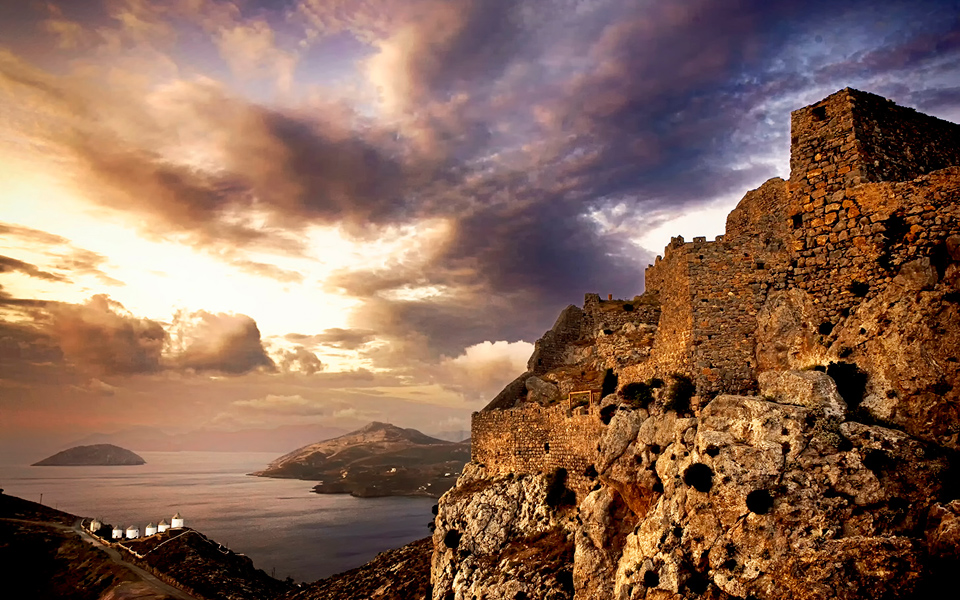A getaway that remains well protected from mass tourism, the Dodecanese island of Leros is ideal for vacationers eager to steer clear of any lifestyle-related razzamatazz during their holidays.
Picturesque fishing villages and a winding coastline of beaches, featuring pine, eucalyptus and tamarisk trees, are a key trait of the island. Leros is also a good place for food enthusiasts, but refined and classy restaurants should not be expected. On the contrary, the local women who prepare the food in the island’s small tavernas serve up culinary wonders. The overall vibe on the island generates a sense of familiarity, making visitors feel like Leros regulars. The island’s mountainous area, where ruins have been left standing, is like an open-air World War II museum. Trekking enthusiasts and divers will love this island for what it has to offer them.

© Perikles Merakos
Enjoy peaceful experiences at the island’s small coves such as Kryfos, located below rocks at a spot where caper bushes grow and fresh water runs from a cave. Vagia features the island’s coldest waters, while a large, lake-like gulf dominates the setting at Partheni. Dyo Liskaria offers a great view of the island’s castle (Kastro) and is surrounded by eucalyptus trees. Alinda and Gourna are ideal family beaches. Aghia Kioura beach, located below a church of the same name, is one of the island’s top swimming choices. Fascinating murals created by political prisoners exiled to Leros during the dictatorship (1967–1974) may be seen at the church.
Go on a boat trip across the turquoise waters and discover the group of nearby islets. Two boats, the Barbarossa and Aghios Georgios, depart from Aghia Marina, the island’s capital, on a daily basis during the summer. Venturing out on these boat trips promises to be a special experience. The boat crews are hospitable. Ouzo and homemade mezes (assorted foods) are offered on board. Aspronisia, Makronisi and Tiganakia, all uninhabited islets, offer complete detachment. Just seagulls, and perhaps the odd Robinson Crusoe-like escapee, may be found here. The few residents on the islands of Arki, Leipsi and Marathi embrace visitors like family. Dolphins often accompany boats returning to Leros.

This island offers rich experiences, a key trait of any visit, including diving adventures. Leros is a renowned diving destination. Seasoned divers may explore shipwrecks, downed airplanes and the legendary Vasilissa Olga (Queen Olga) destroyer. Less experienced divers requiring supervision may contact Kostas Kouvas (Hydrovius Diving Center, Krithoni, tel. +30 22470.26.025). Trekkers are in for a treat along the island’s trails. Besides crossing through wild nature, the paths also bring walkers face to face with pieces of history. Tunnels, canons and other World War II remains may be seen on the island’s mountainous side. Ask for a map marking 14 captivating routes at Leros Active. Visit the Merikia Tunnel War Museum. Absorb the unique architectural beauty and Italian aura at Lakki. Finally, head up to Panaghia (Virgin Mary) Castle via the Platanos area heading towards Aghia Paraskevi. The route requires a climb of 500 steps. The ascent, performed by local worshippers as a religious offering, compensates with an incredible view.
Ignite the romantic soul hidden within you. Aghios Isidoros, located on an islet of the same name, ranks as one of Greece’s most picturesque chapels. Unmarried visitors are bound to be drawn to the prospect of a wedding ceremony here.
GETTING THERE
Leros may be reached from Piraeus port by ferry (9½–11 hours/83 euros return) and by plane from Athens (from 210 euros return)
Try the local culinary delights for breakfast. Look out for the fried pies (tyganopites); gavafa marmalade, made with tropical guava fruit which grows on the island; and laggites (honey-covered dough fritters sprinkled with cinnamon, commonly known as loukoumades elsewhere in Greece). Visitors are also likely to associate the taste of bitter almond with the island as, along with sugar and bread crumbs, it is used to make irresistible pougakia sweets. Almonds are also used to make refreshing soumada, which is common on the island. Paradosiako, located in Aghia Marina, and Glykia Leros, in Panteli, are two good places to sample such breakfast treats.












